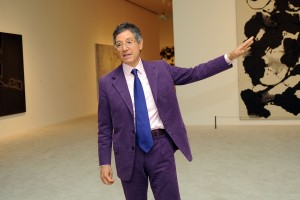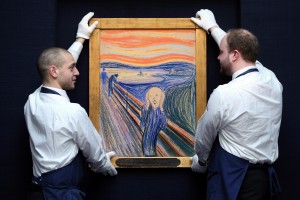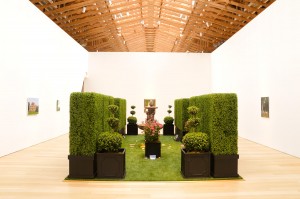By Adam Lindemann
August 7, 2012
In early 2010, when the news broke that a respected art dealer, Jeffrey Deitch, had been named director of the financially struggling Los Angeles Museum of Contemporary Art, the museum’s decision was widely considered a controversial one. This had, of course, happened before: back in the early 1960s, Walter Hopps left his partnership in Los Angeles’s fabled Ferus Gallery to head up the Pasadena Art Museum, where he went on to a successful museum career that included a now-famous Marcel Duchamp exhibition. But who ever said the art world has a long memory? In fact, there have been many role changes in the past few years, including Guggenheim Museum director Lisa Dennison’s departure from the museum to work for Sotheby’s, and Picasso guru John Richardson and, more recently, the Museum of Modern Art’s chief curator emeritus John Elderfield joining the ranks at Gagosian Gallery. As well-financed galleries regularly put on blockbuster shows that are ballsier and more spontaneous than slow-moving museums could ever manage, the role of today’s art institution—and its staff—is at risk and thus up for grabs. Veteran curators are not immune to the smell of money, so it’s no surprise that some of them deservedly want to cash in a few chips. What made the MOCA appointment unusual in this context was that Mr. Deitch went in the opposite direction, giving up his eponymous commercial gallery in order to run a nonprofit institution that needed reinventing. Ironically, instead of receiving praise for his decision to focus on art instead of art commerce, he has been dogged by suspicion, accusations and mistrust from the beginning of his tenure.
The art press has always assiduously followed Mr. Deitch’s moves; his entertainer’s knack for drawing a crowd is one of the main reasons he was chosen to lead the troubled and financially weak MOCA. True to form, he debuted with a newsworthy Dennis Hopper photography show, perhaps a nod to LA’s real art and entertainment history, and to the fact that Mr. Hopper, a real LA cult figure, was dying of cancer. Sadly, he died just before the show went up. Then there was the “Art in the Streets” exhibition, a story Mr. Deitch tells better than anyone, all the way from Basquiat to Banksy. The show was a windfall for the museum, attendance-wise, but the purists continued to gripe and turn up their noses. More recently he did the seriously great “Abstraction After Warhol” show currently on view at the museum, and no one can fault that one, though I’d bet it hasn’t been a crowd-pleaser.
There may have been disagreement in the art community over some of those programming decisions, but it wasn’t until two recent events that all hell broke loose. The dismissal of MOCA’s chief curator, Paul Schimmel, who had been at the museum for 22 years (and the decision not to replace him), was closely followed by Mr. Deitch’s confirmation of an upcoming exhibition dedicated to the era of disco, prompting all four artists on the museum’s board—the luminaries Ed Ruscha, John Baldessari, Barbara Kruger and Catherine Opie—to resign in protest. In response, a lynch mob of art pundits have now joined the witch-hunt. During the initial uproar over Mr. Schimmel’s departure, Mr. Broad, a life trustee who rescued the museum with a $30 million matching grant in 2008, came out in defense of Mr. Deitch in an op-ed in the LA Times, but two weeks ago the paper was mysteriously in possession of a letter that former MOCA chief executive Charles Young wrote to his “friend” Mr. Broad, urging him to fire Mr. Deitch, and now rumors are flying around the art world that Mr. Deitch’s directorship cannot survive such a loss of face and faith.
“I hope that the four-alarm fire now enveloping MOCA has at least given you pause for thought about his appointment and your continued attempts to try to save him for a job for which many (including myself) believe he is unqualified,” Mr. Young wrote in his letter. But before hasty judgments, let’s consider the amnesia relating to why Mr. Deitch was brought in: the institution was under financial duress and had poor attendance for years, and so it tried a new direction with a new kind of director.
As for Paul Schimmel, his departure appears to have been long overdue. I’ve heard rumors from trustworthy sources that he had been shopping around for another position for many years, long before Mr. Deitch entered the picture. I’ve always respected Mr. Schimmel because he is one of the few curators out there who speaks his mind and sticks to his deep commitment to art and artists, but it’s quite possible that his strong opinions and charmingly gruff manner didn’t help him in today’s job market. I know for a fact that Mr. Schimmel was very unhappy with the selection of Mr. Deitch as his boss, and if I knew it he must also have let everyone in town know it.
The art snob in me agrees with much in Mr. Schimmel’s style of curating, but in LA, where a competitor museum, the Los Angeles County Museum of Art (LACMA) and its photogenic director Michael Govan have been absorbing most of the donor dollars, that strategy wasn’t working, and so the board and its main benefactor made a change. Will it ultimately turn out to have been a bad move? It is far too soon to judge Mr. Deitch, but museum goers did increase from 149,000 the year before Mr. Deitch arrived to 402,000 in 2011. Mr. Deitch’s populist blockbuster shows brought people in the door—and that is what he was hired to do.
Then there are the criticisms leveled at Mr. Broad. Instead of the praise he deserves for saving MOCA with a $30 million matching grant, he has been the victim of absurd rumors and allegations related to the private museum he is planning for a site across the street from MOCA. The spiciest blog post, on Coagula Art Journal, went like this: “If MOCA is downsized into a celebrity-curated kunsthalle style circus, it will give the blue chip Broad museum across the street more Gravitas. And then of course when MOCA is broke yet again—who will save MOCA by purchasing the best paintings in the collection because the museum is more concerned with event programming? The Broad Museum across the street of course.” But not all the attacks and rumors have been so easy to laugh off. The respected and influential curator Robert Storr, dean of the Yale University School of Art, weighed in on the affair by heaping bitter criticism on Mr. Broad and his choice: “Dismissing Paul Schimmel in favor of Deitch is like cashing in all your value stocks and doubling down on junk bonds for the sake of a long-shot windfall.”
It always surprises me when patronage of the arts is met with this level of criticism and rebuke, and it certainly won’t encourage others to be generous with their gifts. As far as Mr. Deitch is concerned, his transition from gallerist to museum director was a natural progression; he always put the artists first and the commerce second. Those of us who’ve followed his gallery’s program always knew Jeffrey was never in it solely for the money: the zeitgeist was what his gallery, Deitch Projects, was about, and that’s what MOCA’s board wanted to bring to their museum. Messrs. Schimmel and Deitch were, understandably, oil and water from day one. The day Mr. Deitch was hired, Mr. Schimmel should have been retired with a respectable severance package, one befitting a 20-year veteran (I’m sure he’ll now turn up as an power-adviser at a major gallery just like Messrs. Richardson and Elderfield). I must assume the board was torn, and so for the past two years they decided not to decide, leaving the two men to quarrel in public. This was a clearly a mistake for all concerned, one that ended up further harming the institution’s reputation.
Now those who claim to love the institution are the ones who are putting it at risk. Charles Young was wrong to put down Mr. Deitch in writing; his rebuke, even if in a “private” correspondence with Mr. Broad, was not in the best interest of the institution he claims to care for. The same is true for those revered artists who left the board: to jump ship en masse at this critical juncture is not simply a rebuke of Mr. Deitch and the board’s direction for the museum; their actions have endangered the credibility and the future of the institution.
There is a popular misconception that museums are on rock-solid footing and that patron dollars grow on trees, but the truth is that, in the U.S., our public art institutions are fragile and subject to all sorts of riptides, especially because they receive virtually all of their funding from private donations. Those who purport to love art should not jeopardize the very institutions that preserve it. It’s a sad and irresponsible reaction to an unfortunate case of mismanagement. Right now it’s easy to sling mud and heap blame, and when famous artists join the ranks of those slinging, the situation quickly goes from bad to painfully ugly. I hope MOCA’s trustees will stick to their convictions, steady the ship and stay the course for better and worse. The worst way to weather a storm is to let it push you around. You end up buried in every swell, and that’s a sure recipe for getting dismasted.



